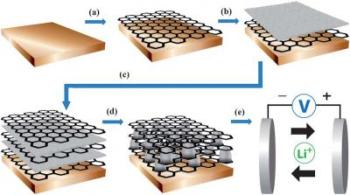Researchers at the U.S. Department of Energy's Lawrence Berkeley National Laboratory have developed a light-weight sandwich structure using tin and graphene.
 Berkeley Lab researchers assembled alternating layers of graphene and tin to create a nanoscale composite.
Berkeley Lab researchers assembled alternating layers of graphene and tin to create a nanoscale composite.
This nanoscale composite structure can be used for providing superior-capacity energy storage in reusable lithium ion batteries, thereby enhancing its performance.
This research was headed by Yuegang Zhang, a scientist in Berkeley Lab's Molecular Foundry of the Inorganic Nanostructures Facility. According to Zhang, an electric vehicle requires a light-weight battery that can retain charge even after continuous cycling and must be charged rapidly. He stated that the design developed by his team enhances battery performance without the requirement of a binder or an additive to operate it.
Graphene is a one-atom-thick carbon material with unique mechanical and electronic properties better than silicon or other semiconductor materials. In this research, the researchers alternatively arranged layers of graphene and tin and formed a nanoscale composite.
Firstly, a thin film of tin was deposited on a graphene sheet. Then, a second graphene sheet was placed atop the tin layer. The procedure was repeated several times and the resulting composite material was heated at a temperature of 3000C in an argon and hydrogen environment. While undergoing this heat treatment, the tin film placed between the graphene sheets changes into a sequence of pillars resulting in height increase of the tin film. This alteration in height improves the performance of the battery’s electrode at the time of electrochemical cycling. It enables to charge lithium ion batteries quickly and frequently without causing degrading which is critical for batteries used in electric vehicles.